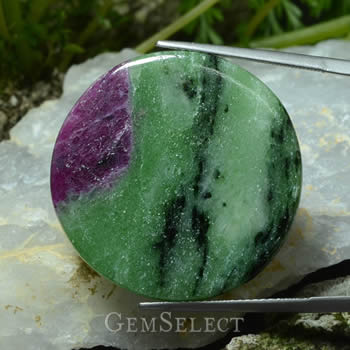Zoisite Gemstones
The mineral, zoisite, was first discovered by the mineral dealer Simon Prešern, who discovered it in the Saualpe Mountains of Austria in 1805. He brought a sample to the Slovenian mineralogist, Sigmund Zois (1747-1819), who recognized it as a previously unknown mineral. It was first named 'saualpite', after its location, then it was named 'zoisite' in honor of Baron Zois.

Tanzanite Gemstone
It sounds like just another story about the discovery of an obscure mineral. But zoisite turned out to be an important gemstone mineral when a new variety of zoisite was discovered in Tanzania in 1967. That find eventually led to the marketing of one of the most popular gemstones of our time; tanzanite. Check out our comprehensive inventory of tanzanite for sale.
The zoisite species includes three notable gemstones: tanzanite, thulite, and anyolite. Composed of calcium aluminum silicate, zoisite has a hardness of 6.5 to 7 on the Mohs scale. When it forms distinct crystals instead of massive chunks, it boasts a high refractive index, just a touch lower than that of spinel.
 |
| Natural Thulite |
Tanzanite is still only found in its first location in Tanzania and is very well-known. However, thulite and anyolite are not. Thulite is an opaque, massive manganese-rich variety of zoisite that is pink in color. It was first discovered in Norway in 1820 and named after the mythical island of Thule. Thulite is usually cut as cabochons or carved into ornamental objects. Since the first find in Norway, deposits have also been found in Western Australia, Namibia and North Carolina in the USA.
Anyolite was first discovered near Longido in Tanzania in 1954. Though considered a variety of zoisite, it is a metamorphic rock that is composed of intergrown green zoisite, black hornblende and ruby. Sometimes it is called ruby-zoisite, since its chief attraction is the interesting contrast of green zoisite and red ruby. The name 'anyolite' apparently comes from the Masai word, anyoli, meaning "green". Discover our range of ruby zoisite for sale.

Ruby-Zoisite Cabochon
Anyolite (ruby-zoisite) is generally carved into ornamental objects. The variable amount of ruby in this material is opaque and of low quality, so there is no attempt to extract the ruby from it. Tanzania continues to be the main producer of anyolite, where it is mined in appreciable quantities for gem carvers and collectors.
|
